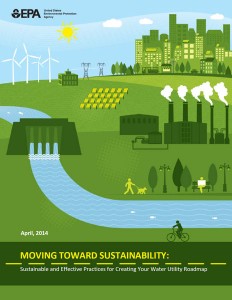The U.S. Environmental Protection Agency (EPA) provides various resources to help water-sector facilities become more sustainable. Recently, EPA released Moving Toward Sustainability: Effective and Sustainable Practices for Creating Your Water Utility Roadmap, to help water resource recovery facilities implement practices to improve operations and move toward sustainability at a pace consistent with facility and community needs.
The steering group, which included many influential Water Environment Federation (Alexandria, Va.) members, that helped develop the document included:
- Lisa Daniels, Pennsylvania Department of Environmental Protection;
- Todd Danielson, Avon Lake Regional Water (Ohio);
- John Hollenbach, United Water of Pennsylvania and Delaware;
- Andy Kricun, Camden County Municipal Utility Authority (N.J.);
- George Martin, Greenwood Metropolitan District (S.C.);
- Michael Mucha, Madison Metropolitan Sewerage District (Wis.);
- Ron Poltak, New England Interstate Water Pollution Control Commission (Lowell, Mass.);
- Dan Roberts, City of Palm Bay Utilities Department (Fla.);
- Tom Sigmund, NEW Water, Green Bay (Wis.); and
- Diane Taniguchi-Dennis, Clean Water Services (Hillsboro, Ore.).
Designed for facilities of various sizes, the document outlines a series of practices that help address challenges, identify opportunities for improvement, and use examples to create individual roadmaps to sustainable operations. Implementing sustainable water infrastructure will help ensure environmental, economic, and social vitality of communities. With the challenges of aging infrastructure, increasing customer expectations, and rising operating costs, facility leaders need practical, flexible, and user-friendly tools.
The document supplements other tools available for effective utility management. Together the tools will help facilities save money by optimizing planning and delivery of services, ensure water availability to meet customer needs, employ energy and water efficient practices and technologies, become resilient in the face of disasters and climate change, and build support from customers and stakeholders.









May 14, 2014
Technologies, WEF Resources & Efforts